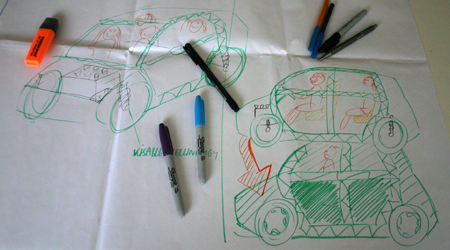Blog
Creative session (part 4): Twingo, the new generation of Renault
Name: New experiences for Twingo 2022.
Date: 22/05/2008.
Duration: 2 hours.
Place: TUDelft Studio 6 / IDE Faculty.
Leader (facilitator): Ricardo Mejia S
Body: Gregorio Muraca
Client: Academic exercise of Automotive Design / Renault
Problem owner: Ricardo Mejia & Marc-Peter Kooistra
Participants: Daniel Moreno, Jelmer Lakerveld, Ling Fong Low, Arjan Kodstra and Riekes Beelen
The goal of the session was created a new experience for the car interior; answering the question: How is possible live an uplifting experience in a Twingo 2022?. Based on the (minor assignment form Automotive Design course at TUDelft) deconstruction of the interior and exterior of the Renault Twingo 2007 the team based on Vision in Product Design (Hekkert and Dijk TUDelft 1997) defined three starting points to work in the design phase:
Design is about possible futures, ViP is interaction centered and ViP is context-driven.
The team had some general rules to create the interaction in the car interior, like: the world in 2022 will be impersonal and chaotic, with small places that are still peaceful and quiet. People need a refugee from their busy working life. When they are not working they need time to relax and take their mind of their professional problems. The social contact is limited because of the high development on the digital communication systems; the people need affection and intimacy. Most of the time people life alone.
The level of the information technology has improved drastically and can communicate very well with the navigational system. And a mission statement: `We want to create an uplifting experience` (In the domain of young starters with a medium income that live or work in the city.)
Methodology and procedure The facilitator prepared several slides in order to describe the situation, the problem (or opportunity), the context of the situation, the rules and the mission statement. Then following this general rules the participants started with a flexible and versatile schedule. Some of the activities that the leader suggests during the session were:
- Icebreaker (10 min) Associations & going round the zoo. Participants received a toy and using a layout of a Zoo, each participant described his place at the Zoo, including the characteristic of the place, his animal, his hobbies and preferences, and why he chose this animal in particular. It was relaxing and playful activity to know each-other according to the suggestions of the Creative Facilitation staff.
- Problem presentation (1o min) Basic rules presentation and problem instruction It was the good opportunity to introduce the rules as presented on the book (Tassoul, 2006): dare to freewheel, postpone judgment, and quality trough quantity and to show the slides with the problem (or opportunity) definition, the context of the situation, the rules and the mission statement.
- Brain-storming about context and cars at 2022 (15 min) It is a diverging phase and associative technique that boils down to a number of people coming with ideas, associating on each other´s ideas and postponing judgment (Tassoul, 2006). All the ideas were written down on a flipchart so that everyone could saw the ideas generated so far. The topic that the facilitator chose for the brainstorming was the 2022 context and cars on that future context.
- Brain-writing about animals and different categories (20 min) The brain-writing is other associative technique consists in a set of formats with two ideas wrote per paper (the name of each animal and a place in the future context (2022); each participant wrote two ideas per topic. After 5 minutes, the formats were passed on the next participant upon whom each participant wrote down another two ideas.
- Coffee-break (15 min) A short football game worked as an energizer to increase the level of attention of the participants.
- Clustering ideas (25 min) After the definition of the context and the brain-storming and brain-writing was time to create groups clustering ideas with some characteristics in common. Using these characteristics three design briefs was made.
- Concluding and presenting (25 min) Finishing the process each team created a basic car-concept for Twingo 2022 using each design brief and filled a format with some illustrations and description of the features of the car.
Results
The final result of the Creative Session was a set of formats with the name of the concept, a short story describing the concept, a list of characteristics, and some illustrations or renderings about the vehicle (a perspective and some views). These three new concepts were evaluated for the team and after that incorporated some of the features and characteristics in the final concept car for 2022.
[nggallery id=12]
Javier Ricardo Mejia Sarmiento



